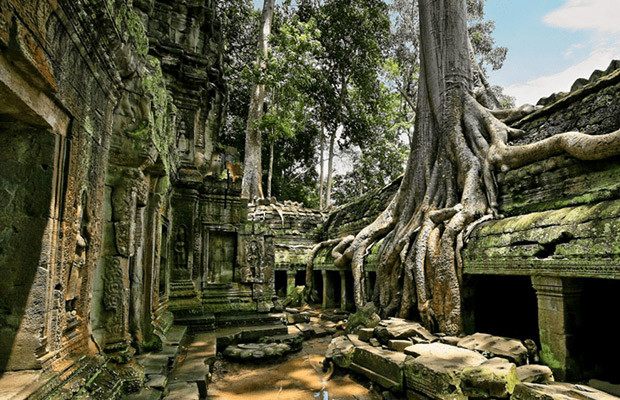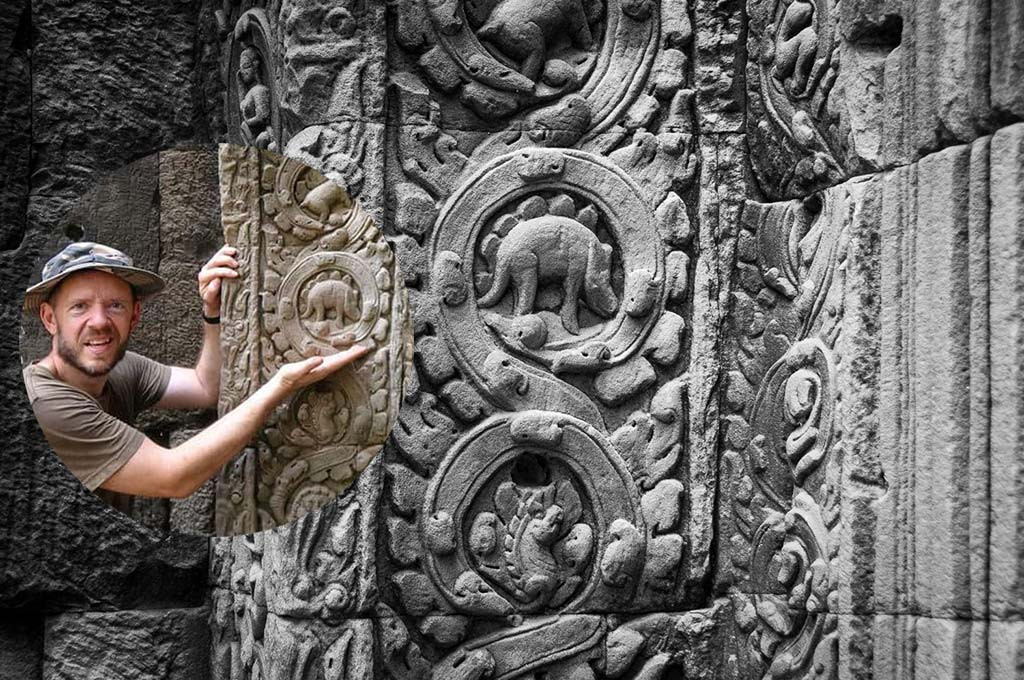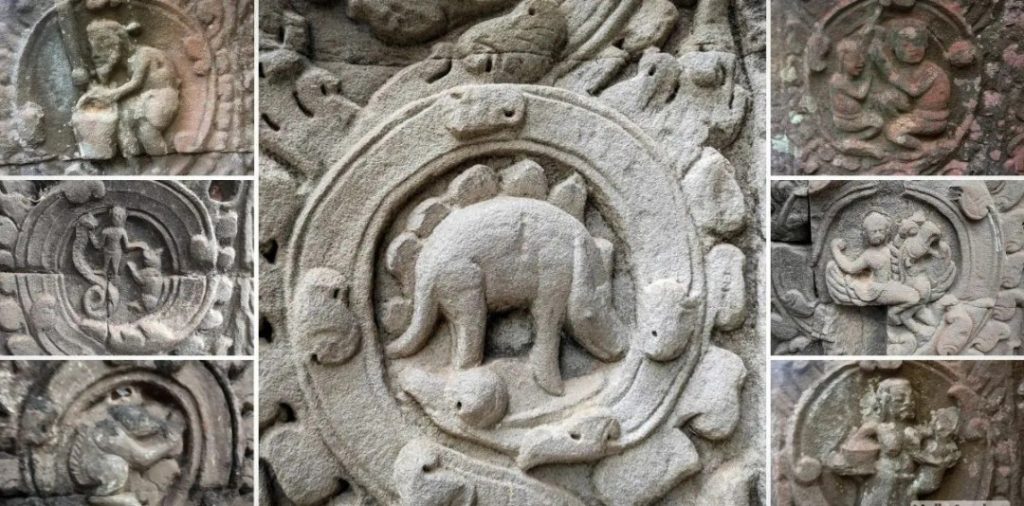In the heart of Cambodia’s lush jungle lies one of the world’s most enigmatic archaeological sites: Ta Prohm, a 12th-century temple-monastery built during the height of the Khmer Empire. Unlike its better-known neighbor Angkor Wat, Ta Prohm is famous for its romantic and mysterious ambiance, as massive tree roots twist through its crumbling walls. Yet, amid its intricate carvings and moss-covered stones, a single bas-relief has captured the imagination of archaeologists, tourists, and conspiracy theorists alike. This particular carving appears to depict an animal that some claim resembles a stegosaurus, igniting debates about its origins and implications for our understanding of history.
The Discovery That Shook History
The story of the so-called “stegosaurus carving” began in the late 1990s when authors Michael Freeman and Claude Jacques published their influential books on the temples of Angkor. Within these pages, they drew attention to a carving at Ta Prohm that seemed to feature a creature with a rounded back and a series of plate-like structures protruding from it—features that immediately reminded some of the iconic dinosaur, Stegosaurus. This revelation sparked a flurry of interest and speculation. Could it be possible that humans and dinosaurs coexisted? Did the ancient Khmer people somehow have knowledge of prehistoric creatures, either through oral traditions or through some incredible discovery of fossils?

As word of the carving spread, the relief quickly became the subject of heated debate, not only among archaeologists but also among enthusiasts of alternative history, creationists, and those fascinated by the idea of ancient mysteries. Some proponents saw the carving as potential evidence that could rewrite our understanding of both history and science.
A Closer Look at the “Dinosaur”
The carving itself, located on one of Ta Prohm’s stone pillars, depicts an animal standing within a circular frame. Its rounded back is adorned with what appear to be lobed or plate-like structures, strikingly similar to the plates that characterize a stegosaurus. However, a closer examination raises questions about this interpretation. Experts in archaeology and paleontology have highlighted several critical inconsistencies that cast doubt on the stegosaurus theory:
- Stylistic Foliage: Many scholars argue that the “plates” are likely stylized foliage, a common motif in Khmer art. Similar decorative patterns can be found in other carvings throughout Angkor’s temples, often framing animals or mythical beings.
- Missing Features: Key anatomical features of a stegosaurus, such as the prominent spikes on its tail (thagomizers), are absent in the carving. Additionally, the creature’s overall body proportions and limb structure do not align with what we know about dinosaur anatomy.
- Ambiguity in Design: The carving lacks definitive details that would conclusively identify the animal as a stegosaurus. Its features are generalized, leaving room for multiple interpretations.
Despite these inconsistencies, the carving continues to fuel speculation. Its ambiguity has made it a focal point for imaginative theories, each offering a different explanation for its origin.
Theories Abound
Over the years, a variety of theories have emerged to explain the Ta Prohm “dinosaur” carving. These range from the plausible to the fantastical, reflecting the diverse perspectives of those who have studied or simply marveled at the relief:
- Living Dinosaur Theory: Some proponents of this idea believe that the carving depicts a living dinosaur observed by the ancient Khmer people. They argue that such an encounter could explain the detailed depiction of what appears to be a stegosaurus. However, this theory faces significant challenges, as there is no evidence in the fossil record to suggest that dinosaurs survived into the time of human civilization.
- Representation of a Known Animal: Another popular theory is that the carving represents a known animal, such as a rhinoceros or chameleon, stylized with artistic embellishments. Khmer art often features animals rendered in imaginative ways, blending realism with creativity.
- Mythical Creature: Given the prevalence of fantastical beings in Southeast Asian art and mythology, some scholars suggest that the carving may depict a mythical creature. Similar carvings in the region include hybrid animals and legendary beasts, emphasizing the Khmer people’s rich tradition of storytelling through art.
- Modern Hoax or Alteration: A more controversial theory posits that the “stegosaurus” carving could be a modern addition or alteration. Proponents of this idea speculate that someone might have modified the original carving to resemble a dinosaur, either as a prank or to attract attention to the site.
The Verdict: Ancient Art or Modern Mystery?
Despite the numerous theories, most experts agree that it is highly unlikely that the Ta Prohm carving depicts a genuine stegosaurus. The advanced Khmer civilization, known for its sophisticated engineering, astronomy, and art, would almost certainly have left behind more substantial evidence if they had knowledge of dinosaurs. The lack of corroborating artifacts, texts, or fossils further undermines the idea that the Khmer people had direct knowledge of prehistoric creatures.

Instead, the carving is more plausibly explained as an example of artistic stylization, cultural symbolism, or even a coincidence of design. The circular frame surrounding the animal, for instance, is consistent with other decorative motifs in Khmer art, which often incorporate elements of nature and mythology.
A Lesson in Interpretation
The “stegosaurus” carving at Ta Prohm serves as a fascinating case study in the challenges of interpreting ancient art. It highlights how our modern perspectives can influence the way we perceive and understand historical artifacts. For some, the carving represents a tantalizing mystery, a glimpse into a lost world of knowledge. For others, it is a testament to the creativity and complexity of Khmer artisans.
This debate also underscores the importance of context in archaeology. Artifacts and carvings must be examined within the cultural, historical, and artistic frameworks of the societies that created them. Without this context, it is easy to project modern interpretations onto ancient works, leading to misconceptions or sensationalized claims.
The Enduring Mystery of Ta Prohm
Regardless of its true nature, the “stegosaurus” carving adds to the allure of Ta Prohm. The temple itself is a marvel of ancient architecture, blending human ingenuity with the untamed power of nature. Its towering trees and sprawling roots create an atmosphere of mystery and wonder, making it one of the most popular destinations for visitors to Angkor.

For those who venture into Ta Prohm’s moss-covered corridors, the “stegosaurus” carving is just one of many intriguing details to discover. Whether you view it as evidence of ancient knowledge, a work of artistic imagination, or simply a curious coincidence, it invites contemplation and sparks the imagination.
As you stand before this enigmatic relief, surrounded by the whispers of the jungle and the echoes of history, you can’t help but wonder: What other secrets might be hidden within Ta Prohm’s weathered stones? While we may never know the full story behind the “dinosaur” carving, it remains a symbol of the endless curiosity and fascination that ancient sites inspire in us all. It reminds us that history is not a static record but a dynamic puzzle, ever open to new interpretations and discoveries.





